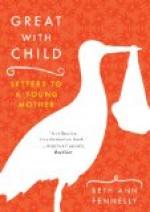In winter, and while there is an infant in the nursery, just beginning to walk, it is recommended by many to cover the floor with a carpet. The only advantage which they mention is, that it secures the child from injury if it falls. But I have seldom seen lasting injury inflicted by simple falls on the hard floor; and there are so many objections to carpeting a nursery, since it favors an accumulation of dust, bad air, damp, grease, and other impurities, that it seems to me preferable to omit it. Many physicians, I must own, recommend carpets during winter, though not in summer; and in no case, unless they are well shaken and aired, at least once a week.
No furniture should be admissible, except the beds for the mother and child, a table, and a few chairs. With the best writers and highest authorities on the subject, I am decidedly of opinion that all feather beds ought effectually and forever to be excluded from nurseries. The reasons for this prohibition will appear hereafter.
Every nursery should, if possible, be free from holes or crevices; otherwise the occupants will be exposed to currents of air, and their sometimes terrible and always injurious consequences. The room may, in this way, be kept at a lower medium temperature—a point of very great importance.
Cats and dogs, I believe, are usually excluded from the nursery; if not, they ought to be. For though the apprehension of cats “sucking the child’s breath,” is wholly groundless, yet they may be provoked by the rude attacks of a child to inflict upon it a lasting injury. Besides, they assist, by respiration, in contaminating the air, like all other animals.
If there are, in the nursery, objects which, from the vivacity or brilliancy of their colors, attract the attention of the child, they should never be presented to them sideways, or immediately over their heads. The reason for this caution is, that children seek, and pursue almost instinctively, bright objects; and are thus liable to contract a habit of moving their eyes in an oblique direction, which may terminate in squinting.
Many parents seem to take great pleasure in indulging the young infant in looking at these bright objects; especially a lamp or a candle. If the child is naturally strong and vigorous, no immediate perceptible injury may arise; but I am confident in the opinion that the result is often quite otherwise. For many weeks, if not many months of their early existence, they should not be permitted to sit or lie and gaze at any bright object, be it ever so weak or distant, unless placed exactly before their eyes; and even in the latter case, it were better to avoid it.
Heat is also injurious to the eyes of all, and of course not less so to children than to adults. But when a strong light and heat are conjoined, as is the case of sitting around a large blazing fire—the former custom of New England—it is no wonder if the infantile eyes become early injured. No wonder that the generation now on the stage, early subjected to these abuses, should be found almost universally in the use of spectacles.




